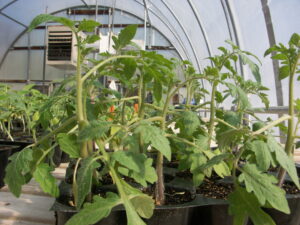We are getting close to the time of year when I begin to get phone calls about strange symptoms on tomato plants in greenhouses. Too often, the problem is ethylene damage. Read on to find out how to avoid this problem.
Tomato plants with ethylene damage often have leaves that are curled down and stems that are twisted (Figure 1). Stems or leaves that are curled downwards are said to have epinasty (in botanical terms). Epinasty is a common symptom of ethylene damage. Ethylene is a common by-product of incomplete combustion of several different types of fuel. Incomplete combustion is often the result of heaters that are not working efficiently. Tomatoes are very sensitive to ethylene damage; however, other crops may also show ethylene damage.

Figure 1. The tomato seedlings above exhibit downward curled leaves (see plant in upper left corner of photo) which maybe a symptom of ethylene damage and yellow seed leaves with lesions, a possible symptom of sulfur damage (Contributed Photo).
The tomato plants in figure 1 also have yellow seed leaves. Ethylene damage does not include yellowing. Furthermore, there is a spotting on the lower leaves that is not typical ethylene damage. I believe that the symptoms on seed leaves were as a result of a different compound, perhaps sulfur dioxide, a heavier than air compound that would remain relatively close to the heater. In fact, the yellowing leaves were observed close to the heater, while the curling leaves, caused by ethylene gas, were spread throughout the greenhouse. The production of sulfur dioxide may also be as a result of incomplete combustion.
While some greenhouses are heated with a furnace attached to the greenhouse, many greenhouses are heated with a standalone unit inside the structure. In the example in figure 1, the grower stated that the heater was of this latter type-a standalone unvented unit. While this type of heating is not recommended, natural gas, propane and kerosene generally burn clean and do not need to be vented. However, even units that burn clean fuels may cause problems if out of adjustment (see citation below).
I cannot prove that the symptoms in Figure 1 above are caused by ethylene. But a few years ago, we witnessed ethylene-like damage at a greenhouse here at the Southwest Purdue Agriculture Center (See article in the November 2007 Vegetable Crops Hotline). Therefore, we were able to confirm that ethylene was the cause of the symptoms shown in Figure 2. Given the similarities of the two examples and the circumstantial evidence, I believe the example given in Figure 1 was due to a heater malfunction. The grower reports that after the heater was serviced, the plants began to look healthier.

Figure 2. These tomato plants are exhibiting epinasty or a downward growth of the leaves in response to ethylene produced from a malfunctioning heater in a greenhouse. The topmost leaves are growing normally because the plants were removed to a separate greenhouse after exposure to ethylene. (Photo by Dan Egel).
Poorly adjusted heaters can also add water to the greenhouse air-as much as 22 gallons of water a night! This unwanted moisture can lead to disease problems.
To avoid damage from ethylene and other air pollutants:
- Have unit heaters checked by a professional and follow maintenance recommendations.
- Assure adequate air supply for complete combustion. For each 2500 BTU’s of heater output, 1 sq. in. of vent cross section is needed.
- Prevent back drafts. Make sure the chimney extends 2 ft. above the ridge of the greenhouse, or 2 ft. above a 10-ft. line to any part of the structure.
- Install an inexpensive carbon monoxide detector. If carbon monoxide levels rise it’s likely ethylene and other pollutants are present also. And if carbon monoxide levels are high it is a significant human health hazard.
- Scout for possible growth effects of ethylene and investigate right away if you see anything.
This article was updated from an article published in Issue 623 in Jan. 2017.